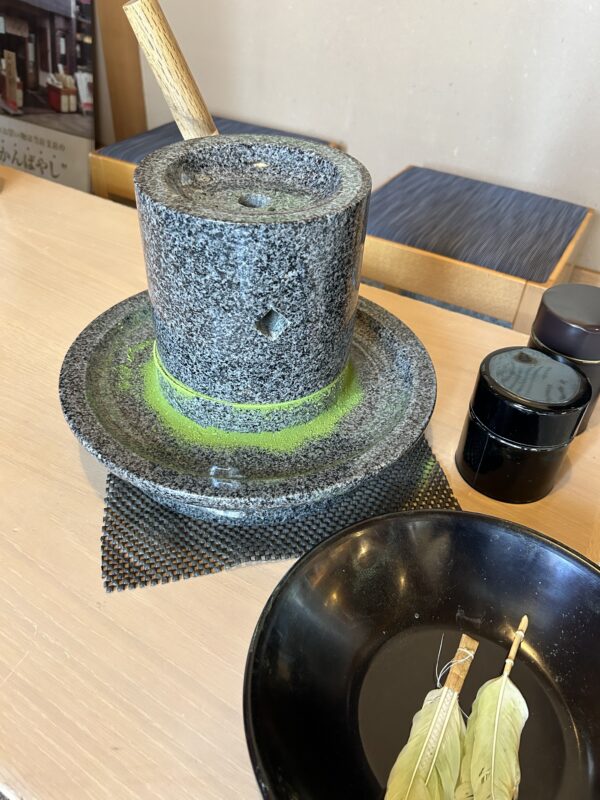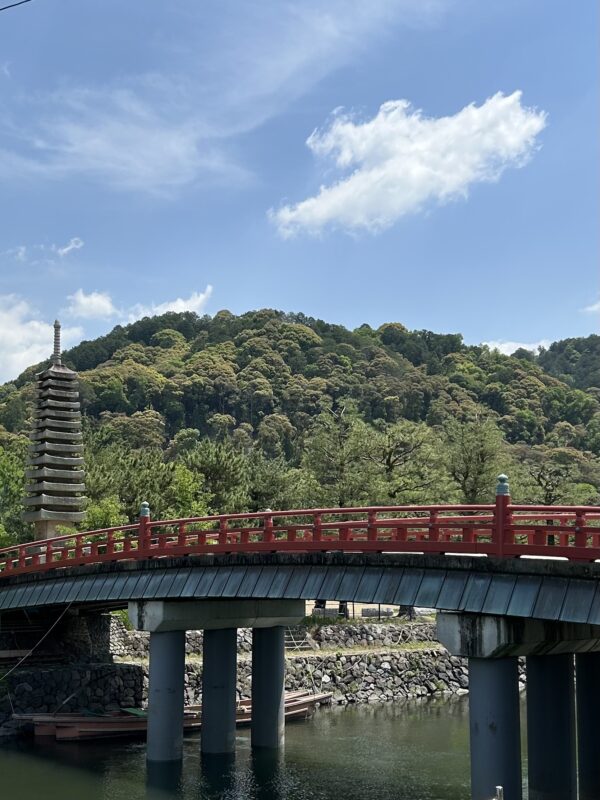
2024.06.08

今は新茶の季節。宇治が忙しい季節です。
気持ちの良いお天気の5月、同僚と宇治へ行ってきました。
美味しいご飯を食べて、美味しいお茶をいただいて、のんびり散策するという
実に幸せな”宇治さんぽ”です。
多くの観光客や修学旅行生が平等院に流れていくのを横目に、
お目当ての辰巳屋さんという老舗の抹茶料理のお店へ向かいました。
1840年に茶問屋として始まり、大正2年に転身されたそう。
目の前の宇治川の川の流れを見ながら個室で落ち着いてお食事ができます。
宇治丸弁当は竹の皮にふんわりとカバーされた、目にも楽しいランチです。
20種類以上のお惣菜がぎっしりと詰まったお弁当。
丁寧に準備されている一つ一つの食材を、じっくりと味わいながらいただきました。
最後にいただいた抹茶のチーズケーキは、和食のお店ならではのもっちりした羊羹の様な食感で
栗が入っていてとても美味しかったです。



大満足のランチの後は”お茶のかんばやし”さんへ、
挽き茶体験プラン(飲み比べ)を試しに伺いました。(要予約)
石臼でお茶を挽くのは勿論初めての体験です。
ご主人がお茶の葉っぱの生産や特徴について、そして機械で挽いた方が甘くて美味しい抹茶が作れることなど
幅広く説明をしてくださいました。
石臼をゴロゴロと回転させてしばらくすると、ようやく細かく挽かれた抹茶が少しずつ出てきました。
鮮やかで明るい緑色のお抹茶。じわじわ出てくるにつれて、嬉しくなってきます。
体験したのは、乾燥した碾茶(抹茶のもとになる葉)を石臼で挽くだけなのですが、
そのプロセスだけでもエネルギーを使います。
お抹茶を飲むのには、生産から粉になるまでの多くの人の手と工程を経なければならない事がわかりました。
機械化されてはいるものの、小さな缶に入った抹茶が高級であることを改めて実感し納得したのでした。
挽き茶体験の後は、自分で挽いたお抹茶と工場で挽き上げたお抹茶とを飲み比べてみます。
先ずは、季節の和菓子ヨモギ餅と共に工場のお抹茶を、
そしてその後は自分で挽いたお抹茶をいただきました。
後者は味わいも舌触りも粗く、工場生産の方が圧倒的に美味しかったです。




お抹茶をいただきながら、同僚とお茶にまつわるおしゃべりを沢山楽しみました。
「時間に追われる自分自身に時間をあげる為にお茶を飲む、自分をゆるめるという意識でお茶を飲む」
ということの大切さを彼女が教えてくれました。
「なるほど!お茶とは、ただのどを潤してホッ一息つくというものではなくて、
自分に時間をあげるためのお茶という位置づけもあるのか。」という新しい発想に驚いたのでした。
例えばティーバッグで手軽に飲むことは、忙しい生活の中では当たり前だし便利だけど、
それは単なる動作でしかなくなるのだと。
昔は、急須にお茶っ葉を入れる、お湯を沸かす、その流れを楽しむ。
今は出来上がったものをすぐに味わう、つまり作らないので早い。
自分で作ることをしないと単なる動作になるという解釈です。
お茶やコーヒーを丁寧に淹れて飲む流れや時間を楽しんでいる同僚は、
きっとそういった時間のお陰でとても癒され、
だからとても穏やかに日々を過ごしているんだろうなと思いました。
彼女によると江戸時代はとてもサステイナブルな時代だったそうです。
器は欠けたら直す、食べ物も大切に食す、何も無駄にならない時代 食べ物も人も豊かだった時代。
そんなところにまで話が広がりました。
家でも”一日一回お茶を飲む時間=自分をゆるめる時間”を持とうと思えた宇治さんぽの一日でした。
ほとりでも、ゆったりと寛いでいただける様に美味しいお茶を準備しています。
ティーバッグですが、どうぞごゆっくりお過ごしくださいね。



Now is the season for new tea! I went to Uji with my colleague in May when the weather was pleasant. It was a very happy “Uji stroll-day,” with delicious food and delicious tea.
While many tourists and students on school excursions were streaming into Byodo-in Temple, we headed to Tatsumiya, a long-established restaurant serving matcha green tea dishes, which I was looking forward to visiting.
It started as a tea wholesaler in 1840 and changed its name to Tatsumiya in 1913. You can dine calmly in a private room while watching the Uji River flow in front of you. Ujimaru bento lunch is a feast for the eyes, softly covered in bamboo bark and packed with more than 20 different side dishes. We took our time savoring each carefully prepared ingredient. The green tea cheesecake we had at the end was delicious, with a yokan-like texture and chestnuts that only a Japanese chef can offer.
After lunch, we went to “Ochano Kanbayashi” to try out the ground tea experience plan “comparison of matcha” (reservation required). Of course, it was my first time to grind tea using a stone mortar. The owner gave us a wide-ranging explanation about the production of tea leaves and their characteristics, as well as how to make sweeter and tastier matcha by grinding it with a machine. After a while of rumbling and spinning the millstone, the finely ground matcha finally came out little by little. The bright green powder of matcha, what I experienced was just grinding dried tencha (the leaves from which matcha is made) with a stone mortar, but the process alone uses a lot of energy. We learned that drinking matcha requires many human hands and processes from production to powder. Although it is mechanized, I was convinced once again that matcha in a small can is a high quality product.
After the ground tea experience, we compared the matcha we ground ourselves with the matcha ground at the factory. We enjoyed the factory’s matcha along with seasonal Japanese sweets, mugwort rice cakes. After that, I had the matcha that I ground myself. That one was coarser in taste and texture, and the factory-produced one was by far the tastiest.
Over two cups of green tea, I enjoyed many tea-related conversations with my colleague.
My colleague taught me the importance of drinking tea with the awareness of loosening oneself up.
I see! I was surprised to learn that tea is not just for quenching one’s thirst and taking a breather, but for giving oneself time to relax.
For example, drinking tea easily in a tea bag is common and convenient in today’s busy life, but it is no longer just an action.
In the past, people would put tea leaves in a teapot, boil water, and enjoy the process.
Nowadays, we can taste the finished product immediately without having to make it and not making it ourselves becomes just an action.
I thought that my colleagues who enjoy the flow and time of carefully brewing and drinking tea and coffee must be very healed by such time, and that is why she spend her life very peacefully.
She said that the Edo period was a very sustainable era. If a cup was chipped, it was repaired, food was eaten with care, and nothing went to waste. It was a time when food and people were abundant. The conversation at tea time expanded to such a point.
It was a day of walking in Uji that made me realize that I should take time to relax and have a cup of tea once a day, even at home.
At hotori, we have prepared delicious teas and nice tea pot .
Please relax and enjoy tea time!
Mikko
